This article has been reviewed according to Science X's editorial process and policies. Editors have highlighted the following attributes while ensuring the content's credibility:
fact-checked
trusted source
proofread
Q&A: Searching for life where it shouldn't exist
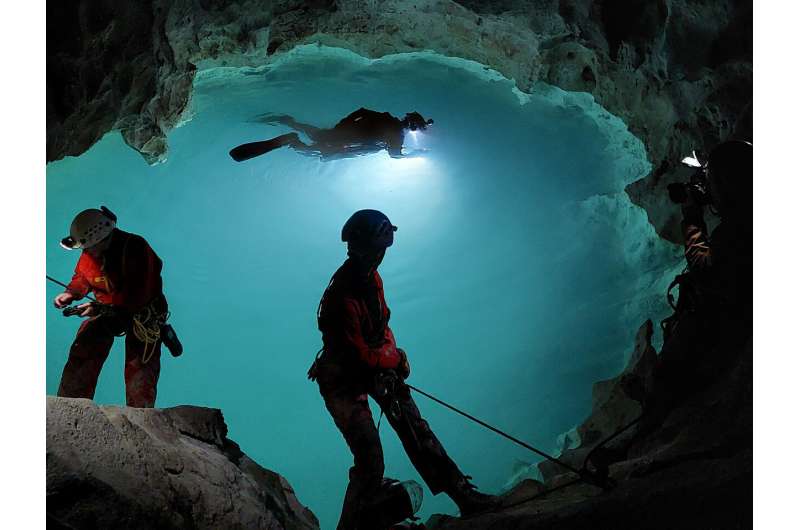
A team of Penn State scientists is working to solve one of the world's greatest unsolved mysteries: how life originated on Earth—and how it might have evolved on other planets.
Jennifer Macalady, professor of geosciences at Penn State, is a microbiologist who studies biological interactions between the limited resources that were available on early Earth: water, atmospheric gases and rocks. Her research takes her to some of the most hostile places for life on Earth, in search of the microbial biofilms that can survive there.
Her most recent expedition was to three lakes within Italy's Frasassi cave system, accompanied by Dani Buchheister, a doctoral student in geoscience and astrobiology at Penn State. The project is featured in the October issue of National Geographic. Macalady and Buchheister spoke with Penn State News to explain more about the scope of work.
Q: Before we get into the specifics of the expedition you led in February that is featured in the magazine, what can you tell me about your research more broadly?
Buchheister: We're interested in the sort of life that survives in unique, or even hostile, environments. We want to understand what that can tell us about the limits of life in general and, more specifically, how life might exist on other planets.
Macalady: I would second that and add that we're particularly interested in microbes we've never met. The motivation for that is that we want to understand the diversity of this planet's microbes. The diversity we know about is limited and influenced by where we have looked. The subsurface of our planet is the least-explored habitat on Earth, so it's a natural place to look for life we've never seen before.
Q: And what specifically are you hoping to understand?
Buchheister: The most motivating part of the research for me is learning what microbes are doing to survive in these extreme environments. Take for instance this site in Italy, it's a cave lake that doesn't have a lot of movement in its waters, it's stratified, so there is layer upon layer of groundwater where biofilms are growing without detectable amounts of oxygen. The biofilms are missing a lot of the common ingredients available at the surface for microbes to grow, but by all accounts, they are alive.
Macalady: The microbes living deep underground have to employ different strategies than what we see on the surface. They are living under conditions that are more akin to what we think early Earth was like, before the Great Oxidation Event, before Earth's atmosphere and surface were exposed to high oxygen like they are today. By studying microbes deep underground, we can learn how they get energy from an environment that doesn't have sunlight or oxygen, which are the main resources that fuel life on the surface.
Q: How can you use that to understand how life evolved here or possibly on other planets?
Macalady: We're talking about life that can manage with just rocks and water and the interactions between the two. Early Earth was such an alien place. It really was not the same planet we live on today, so there is not much of a leap between studying environments that might represent the very early Earth to thinking about environments on other planets.
Buchheister: This environment we're exploring inside the Earth's subsurface in Italy has a particular kind of chemistry that helps create biofilms capable of harnessing energy from almost nothing. They have a metabolism, so a big thrust of my motivation is learning more about how that metabolism works and what that can tell us about life on early Earth and the possibility of life on other planets.
Macalady: Something that can thrive off of a geological system, just rocks and water, is pretty special. The specific metabolism Dani is interested in is essentially a missing way of life, one that is either extinct or carried out by microbes that we have never met. There are so many better gigs for life now. There are so many other, more juicy ways of making a living. When life started or close to the origin of life, there were far fewer options. The reaction that Dani is researching is also special in the sense that scientists have imagined it being the very first metabolism on Earth.
Q: It must be so thrilling to one the forefront of exploration like this. How does that feel?
Buchheister: It's exciting because there are so many unknowns about this biofilm. What is in it? What are those microbes are doing? Why are they there and how do they grow? There is so much we don't know, which is an amazing space to operate in as a scientist.
Macalady: It also makes it particularly challenging, because the methods used to study microbes were not designed for novel forms of life we've never seen before. A commonly studied bacterium like E. coli might divide in an hour and would be relatively easy to sample and analyze, but the kinds of organisms that we're looking for are very, very challenging to detect, much less grow in a lab. Persistence is required.
-
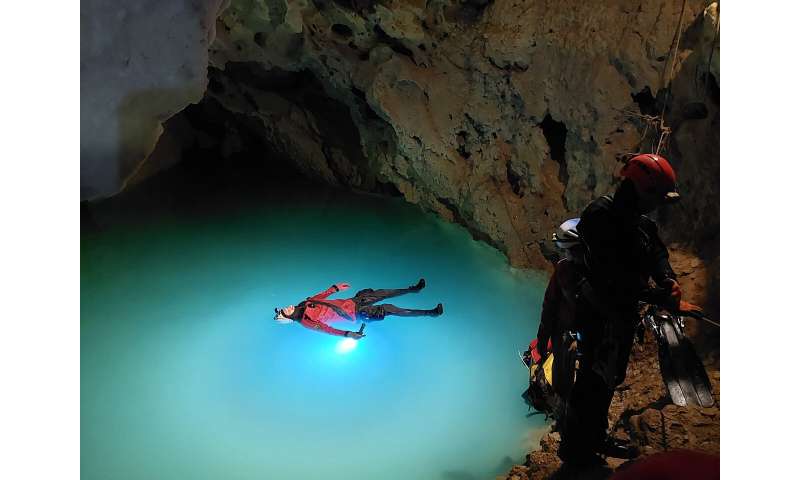
Cave diver Nadir Quarta floats in Lago dell'Orsa while waiting his turn to ascend to the cave entrance. Credit: Dani Buchheister/Penn State -
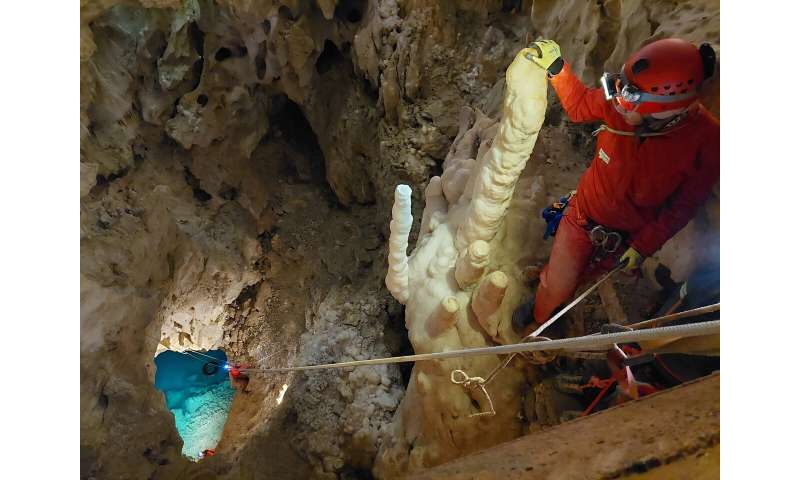
Underwater photographer Shireen Rahimi peers down the 80 foot drop to Lago dell'Orsa, one of the biofilm sampling locations. Credit: Dani Buchheister/Penn State -
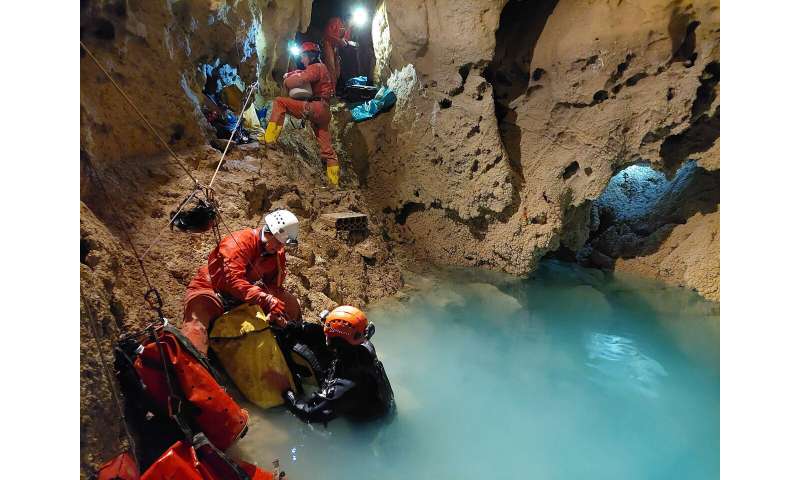
Penn State professor Jennifer Macalady (left) assists diver Kenny Broad with gear in preparation for a sampling dive. Credit: Dani Buchheister/Penn State -
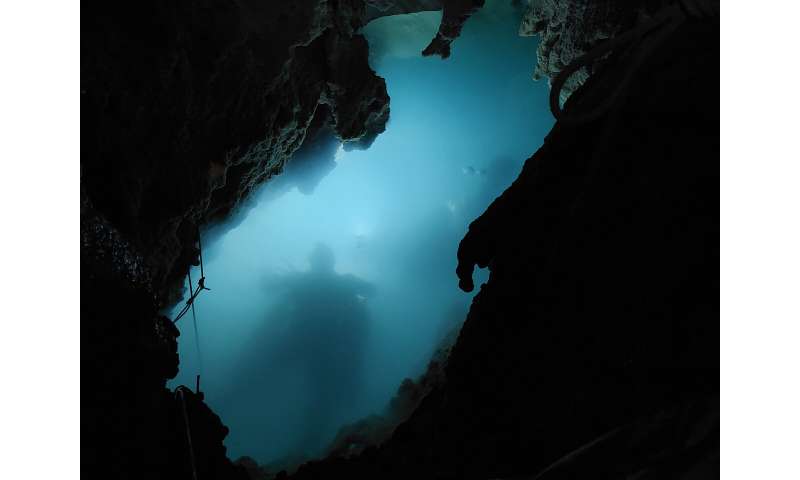
The silhouettes of divers Nadir Quarta and Kenny Broad can be seen in Lago dell'Orsa as they descend in search of biofilms to sample. Credit: Dani Buchheister/Penn State
Q: There's also a lot of logistical challenges involved in getting the samples to begin with, correct?
Macalady: Our ability to sample deep underground is heavily dependent on collaborations with both experienced technical divers and local Italian cave explorers, who help us get to where we need to go safely. The collaboration is really fundamental, and our work would be impossible without the support of an entire team of people on every expedition. The local cavers are essentially citizen scientists who have been exploring these areas in support of our research for 20 years, and their accumulated knowledge and skill is invaluable to our research.
Q: What goes into building those relationships, because I imagine trust is literally vital when you're working in these conditions?
Macalady: That's absolutely true. We're very careful about which cavers and divers we work with, and we're very clear about the parameters of that relationship in terms of safety and appropriate levels of training. I prefer to work with divers and guides who are not overly excited or enthusiastic but are more reserved and calculated.
I prefer a diver who says, "That's too complicated" or "That is going to take multiple dives and more time than you want." It's always nerve-racking when the divers are in the water, but when you have a very measured team to plan with, it is a little less stressful.
Buchheister: I should add that, in my experience so far, the divers are genuinely excited about the work once they get a sample back up on dry land. It is intense focus on our respective tasks before that moment, but afterwards there is this amazing, celebratory mood when everything is accomplished the way we set out to do it. It's been awesome to experience that.
Q: What are the next steps for the team?
Macalady: We're planning a trip back to the same site in Italy to do more thorough cataloging of the chemistry of the lakes, as well as leaving behind some dataloggers that will track chemistry in the water over time, while we're not there. We are also experimenting with a remotely operated submersible vehicle that one day could take the burden off of human divers in the research.
Buchheister: Since we're able to go there only so often, we're only getting a momentary snapshot of the system. We're hoping that by leaving dataloggers behind, we can see over a few seasons whether or not there are substantial changes in the chemistry of those waters that can have implications for what the microbes are doing down there.
So, a lot of future work in the field is going to be oriented around understanding the environmental context of where these microbes are growing. And of course back in the lab, a lot of patient waiting for microbes to grow using only water and rocks.
Provided by Pennsylvania State University





















